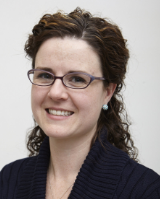Cheryle A. Séguin

Professor
PH.D. University of Toronto
M.Sc. University of Western Ontario
B.Sc. University of Western Ontario
Office: Dental Sciences Building, Room 0035A
p. 519.661.2111 x. 82977
f. 519.850.2459
e. cheryle.seguin@schulich.uwo.ca
Visit Dr. Séguin's Website
See Publications by Cheryle Séguin on PubMed
My research program centers on understanding the pathways that regulate the fate and function of cells, with a particular emphasis on the intervertebral disc and spine pathologies. This research is particularly relevant given that back pain is the most frequently reported musculoskeletal problem in Canada, and the second most common cause for visits to physicians in North America. The lack of effective treatment for this widespread clinical problem is related to our limited understanding of the specific cell types and pathways regulating intervertebral disc development and disease.
To address this, my research program involves a number of interrelated projects that use novel genetic mouse strains, and in vivo and ex vivo model systems.
-
Fate mapping intervertebral disc cells. The first studies from the Séguin lab addressed a long-standing debate by interrogating the developmental origins intervertebral disc cells. Using a novel notochord Cre mouse, we demonstrated that all cells in the nucleus pulposus are of notochordal origin. This work enabled the development of techniques for notochord cell isolation, culture and phenotypic characterization.
-
Notochord-specific gene knockout models. We are examining candidate factors in the intervertebral disc by targeted gene deletion. Our recent studies reported notochord-specific CCN2 knockout mice, and demonstrated that expression of this matricellular protein by notochord-derived cells regulates disc development and age-associated disc degeneration.
-
Models to examine mechanobiology in joint tissues. We have integrated expertise in spine biology into collaborative research, including the use of mouse models to study mechanobiology in joint tissues. We demonstrated a cell autonomous response of intervertebral disc cells to acute vibration, and ongoing research is examining the response to chronic mechanical loading.
Our ultimate goals are:
- to understand how the notochord directs embryonic intervertebral disc formation
- to establish the phenotype of distinct disc cell types and understand how cell function is altered with age and mechanical load
- to determine if processes associated with disc formation can be re-initiated for tissue repair or to treat disc degeneration
Publications (trainees from the Séguin lab underlined)
Bedore JM, Leask A, Séguin CA. Targeting the extracellular matrix: matricellular proteins regulate cell-extracellular matrix communication within distinct niches of the intervertebral disc. Matrix Biology. 2014 May 27; Epub ahead of print (Invited review)
Bedore JM, Sha W, McCann MR, Liu S, Leask A, Séguin CA. (2013) Impaired intervertebral disc development and premature disc degeneration in mice with notochord-specific deletion of CCN2. Arthritis and Rheumatism, 65(10):2634-44. (Featured on cover)
McCann MR, Patel P, Beaucage KL, Xiao Y, Bacher C, Siqueira WL, Holdsworth DW, Dixon SJ, Séguin CA. (2013) Acute vibration induces transient expression of anabolic genes in the murine intervertebral disc. Arthritis and Rheumatism, 65(7):1853-64
Warraich S, Bone DBJ, Quinonez D, Ii H, Choi D-S, Holdsworth DW, Drangova M, Dixon SJ, Séguin CA, Hammond J§. (co-senior author) (2013) Loss of Equilibrative Nucleoside Transporter 1 (ENT1) in Mice Leads to Progressive Ectopic Mineralization of Spinal Tissues Resembling Diffuse Idiopathic Skeletal Hyperostosis (DISH) in Humans. J Bone Miner Res, 28(5):1135-49
McCann MR, Tamplin OJ, Rossant J, Séguin CA. (2012) Tracing notochord-derived cells using a Noto-cre mouse: implications for intervertebral disc development. Disease Models & Mechanisms 5(1):73-82. (Featured on cover)
Hotta A, Cheung AYL, Farra N, Vijayaragavan K, Séguin CA, Draper JS, Pasceri P, Maksakova IA, Mager DL, Rossant J, Bhatia M, Ellis J. (2009) Enriched isolation of reprogrammed human iPS cells using EOS lentiviral vectors to select for pluripotency. Nature Methods 6(5):370-6.
Séguin CA, Draper JS, Nagy A, Rossant J. (2008) Induction of endoderm differentiation by SOX transcription factors in human embryonic stem cells Cell Stem Cell 3(2):182–195. (Featured on cover)








